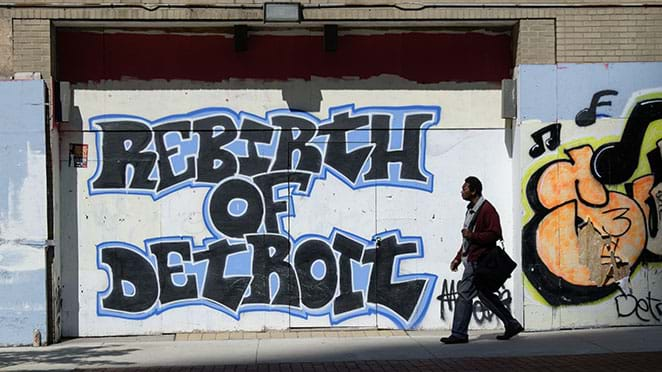 James Fassinger/Corbis
James Fassinger/CorbisOriginally published in the Detroit Free Press, Nov. 9, 2014.
Read more news and commentary on the city’s next chapter.
This past June, I found myself sitting, awestruck, in the Rivera Court of the Detroit Institute of Arts. The court is named after Rivera for his breathtaking “Detroit Industry” frescoes that line the walls—a gift from Edsel Ford to the people of Detroit back in 1932.
The 27-panel masterpiece remains a monument to human endeavor and hard work. Eight decades after Rivera put down the paintbrush, it was still the perfect backdrop for the event I was attending.
That afternoon, I watched as the Detroit Three auto companies—Ford, Chrysler, and GM—committed $26 million toward Detroit’s nearly $900-million grand bargain. Leaders and emissaries from government, philanthropy and business proudly looked on. A sense of joy and relief filled the air.
Yet, what moved me most was neither the actions of the power brokers nor the timelessness of the paintings. It was two city retirees, who, unaffected by the fanfare, sat quietly and with dignity at the front of the room. Their names were not printed in the program, but their life work—and the hard work of so many others who they were there—was what inspired the idea of the grand bargain.
Shirley Lightsey and Don Taylor are advocates for the city and its residents. They and thousands of their colleagues faced the tough choices on which the grand bargain hinged. And they made those tough choices. These city-makers—quiet but indefatigable leaders—were what the grand bargain was all about. And, for Detroit’s sake, we must never forget that.
Shirley and Don represent the people who made Detroit one of the world’s greatest centers of industry and art, and who stuck with it during unimaginably hard times. They are the firefighters, the police officers and the civil servants who, once again, showed up for duty and delivered. They are the retirees who came to the table and negotiated in good faith—even, frankly, when it seemed that every option was a bad one—because it was simply the best thing for Detroit.
People with character like this are the whirring, humming engines of the Motor City. It is the toil and sacrifice of these humblest of heroes—not government, or business or philanthropy—that have laid the groundwork for Detroit’s renewal.
Now, as Detroit’s emergency-management process draws to a close, it is precisely this example that stands as a powerful challenge to the rest of us. Detroit’s elected officials must demonstrate the same commitment and resolve that has been shown so nobly by its residents. It is encouraging to already hear Mayor Mike Duggan and other city leaders talk about a culture of inclusion, transparency and management excellence as essential to the city’s future.
For foundations like the one I serve, what’s important is not just what we did this year, but also what we do in the years ahead. We will bring attention to the need to fund grassroots, community-led efforts to revitalize the city from the ground up. And, in doing so, we’ll strive to meet the standard of integrity, heart and leadership shown by Detroiters like Shirley and Don and captured in Rivera’s frescoes.
There is much work to do. Hard work. But Detroit, as ever, is a city full of women and men who know how to get the job done. We stand with them—not just in the grand bargain, but in an even grander future.
